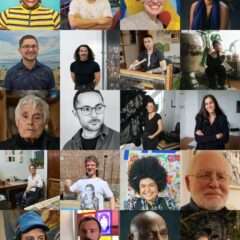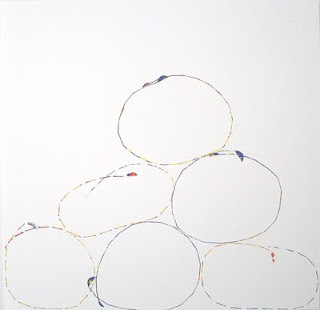
Rachel Perry Welty Let there be Cuties (2008) fruit stickers and archival adhesive on paper, 11″ x 11″, courtesy Gallery Joe
Old City is full of interesting work at the moment. Libby’s already covered the array of artists at Gallery Joe and I second her enthusiasm although she only gave brief mention to Rachel Perry Welty’s “drawings” made from fine lines cut out of fruit stickers (which I assume are those dreadful little labels that I always peel off before putting the fruit in the bowl). They are actually collages but have the simplicity and look of effortlessness of Zen ink drawings. They are very beautiful, even if I don’t know why Welty goes to those lengths to create them.
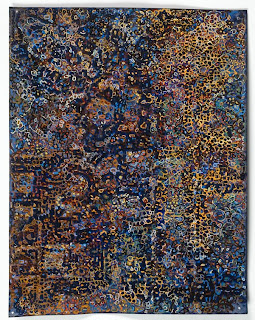
David Ambrose The Conflicting Plans of Spain and England, 11 x 8 inches, watercolor, gouache on pierced paper, courtesy Pentimenti Gallery
David Ambrose‘s work at Pentimenti, a series called The Braille Landscape, is clearly labor-intensive. He first creates patterns by pricking thick paper from behind then applies tiny, multi-colored cells over the entire image. This produces an effect akin to the glassmaking technique called millefiori; Ambrose has both the fine hand and eye (as well as the patience) of a medieval illuminator. In the most successful pieces the results remain abstract (although they occasionally resemble maps); I am less taken with the works where the cells coalesce into either repeating geometric forms, as in oriental carpets, or become recognizable figures. Still, they are all fascinating works, intended to be seen up close (and given the series title perhaps they are also meant to be touched) and would re-pay repeated viewing.
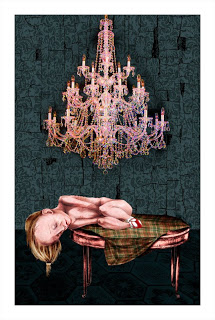
Silicon Gallery is exhibiting a recently completed portfolio of ten pigment prints by Judith Schaechter. Silicon manages to achieve astonishingly saturated and glowing colors which are the perfect medium for Schaechter, as they capture the luminosity that she usually achieves in her glass “paintings”. Some of the digitally-generated imagery is taken from the glass works (although the images are re-created for the prints, not scanned); others are original to the prints. The majority of them continue her subject of girls lost in hallucinatory environments that may be dreams of their imagining or of Schaechter’s own alternate reality.
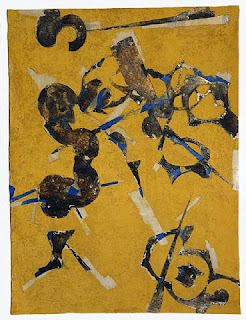
Dove Bradshaw Quick Construction with Yellow and Blue (2008) Meproof yellow, silver, liver of sulfur, tape, varnish and beeswax on paper, 25.8″ x19.2″, courtesy Larry Becker Contemporary Art
Larry Becker Contemporary Art is extending the exhibition of Dove Bradshaw‘s drawings, collages on paper, “drawings” on silver and three constructions which use crystals to capture radio waves. Bradshaw has long been associated with Merce Cunningham (for whom she designs sets and costumes) and John Cage, and has been notably influenced by Cage’s use of chance. I’m most intrigued by the works on paper, a series ironically called Quick Constructions. In fact they employ a laborious technique, but their beginnings with pieces assembled at random recalls not only Cage but Duchamp, in works such as Three Standard Stoppages (1913-14) which was generated by dropping three one-meter lengths of thread from a height of one meter.
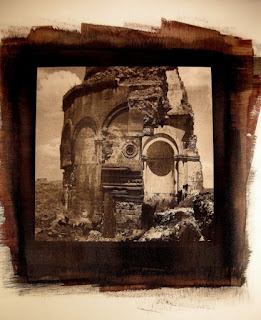
John Joyce from a series on Ani, mixed photographic media, courtesy Gallery 51
Gallery 51, which usually shows extraordinary exhibitions of middle-Eastern textiles has a group of John Joyce’s photographs of the deserted ruins of the ancient Armenian capital of Ani (at the edge of modern Turkey). In keeping with the ruinous state of the buildings he’s used a combination of archaic photographic media, one of which is platinum palladium printing (my notes on his other technique are incomplete); I do remember that each image is printed three times. I’m not sure what I make of the conceit, but he has produced images of real beauty (with a subtle glow when seen at close range) of a historic site that may not survive.



